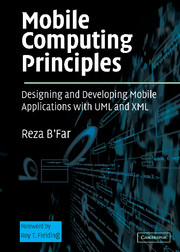Book contents
- Frontmatter
- Contents
- Foreword by Roy T. Fielding
- Acknowledgments
- SECTION 1 INTRODUCTIONS TO THE MAIN TOPICS
- SECTION 2 DEVICE-INDEPENDENT AND MULTICHANNEL USER INTERFACE DEVELOPMENT USING UML
- Chapter 5 Generic User Interface Development
- Chapter 6 Developing Mobile GUIs
- Chapter 7 VUIs and Mobile Applications
- Chapter 8 Multichannel and Multimodal User Interfaces
- SECTION 3 ADDITIONAL DIMENSIONS OF MOBILE APPLICATION DEVELOPMENT
- SECTION 4 PUTTING THE PROJECT TOGETHER
- References
- Index
Chapter 6 - Developing Mobile GUIs
from SECTION 2 - DEVICE-INDEPENDENT AND MULTICHANNEL USER INTERFACE DEVELOPMENT USING UML
Published online by Cambridge University Press: 03 September 2009
- Frontmatter
- Contents
- Foreword by Roy T. Fielding
- Acknowledgments
- SECTION 1 INTRODUCTIONS TO THE MAIN TOPICS
- SECTION 2 DEVICE-INDEPENDENT AND MULTICHANNEL USER INTERFACE DEVELOPMENT USING UML
- Chapter 5 Generic User Interface Development
- Chapter 6 Developing Mobile GUIs
- Chapter 7 VUIs and Mobile Applications
- Chapter 8 Multichannel and Multimodal User Interfaces
- SECTION 3 ADDITIONAL DIMENSIONS OF MOBILE APPLICATION DEVELOPMENT
- SECTION 4 PUTTING THE PROJECT TOGETHER
- References
- Index
Summary
The rose and the thorn, and sorrow and gladness are linked together.
SaadiINTRODUCTION
In Chapter 5, we saw why and how to build generic user interfaces. The two types of interfaces that dominate computing today are Graphical User Interfaces (GUIs) and Voice User Interfaces (VUIs). So, when we specialize a generic user interface, we are typically specializing it to either a GUI (of which we will consider text-only user interfaces to be a subset) or a VUI. In this chapter, we will look at GUIs, in Chapter 7 we will look at VUIs, and in Chapter 8 we will see how to build multimodal user interfaces that use multiple channels to reach the user.
Let us remember our final goal: building mobile user interfaces. Mobile user interfaces inherently have different requirements than their stationary counterparts because of the dimensions of mobility and the mobile condition of the user. The dimensions of mobility affect design and implementation of user interfaces in two fundamental ways. The first is that the user interface has to accommodate functionality that relates to the dimensions of mobility. For example, user interfaces must be available on all of those devices through which the user of an application may access a system. Second, the dimensions of mobility create various concerns that require further separation of concerns when building user interfaces.
- Type
- Chapter
- Information
- Mobile Computing PrinciplesDesigning and Developing Mobile Applications with UML and XML, pp. 316 - 398Publisher: Cambridge University PressPrint publication year: 2004



